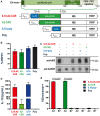Chimeric antigen receptor-modified human regulatory T cells that constitutively express IL-10 maintain their phenotype and are potently suppressive
- PMID: 34320225
- PMCID: PMC8581768
- DOI: 10.1002/eji.202048934
Chimeric antigen receptor-modified human regulatory T cells that constitutively express IL-10 maintain their phenotype and are potently suppressive
Abstract
Clinical trials of Treg therapy in transplantation are currently entering phases IIa and IIb, with the majority of these employing polyclonal Treg populations that harbor a broad specificity. Enhancing Treg specificity is possible with the use of chimeric antigen receptors (CARs), which can be customized to respond to a specific human leukocyte antigen (HLA). In this study, we build on our previous work in the development of HLA-A2 CAR-Tregs by further equipping cells with the constitutive expression of interleukin 10 (IL-10) and an imaging reporter as additional payloads. Cells were engineered to express combinations of these domains and assessed for phenotype and function. Cells expressing the full construct maintained a stable phenotype after transduction, were specifically activated by HLA-A2, and suppressed alloresponses potently. The addition of IL-10 provided an additional advantage to suppressive capacity. This study therefore provides an important proof-of-principle for this cell engineering approach for next-generation Treg therapy in transplantation.
Keywords: Cell therapy; Chimeric antigen receptor; IL-10; Regulatory T cell; Suppression.
© 2021 The Authors. European Journal of Immunology published by Wiley-VCH GmbH.
Conflict of interest statement
GL and RIL are stakeholders of Quell Tx Ltd while YRM and SLT have been employed by Quell Tx Ltd after completing practical work leading to this manuscript. The other authors declare no commercial or financial conflict of interest.
Figures



Similar articles
-
Precision Engineering of an Anti-HLA-A2 Chimeric Antigen Receptor in Regulatory T Cells for Transplant Immune Tolerance.Front Immunol. 2021 Sep 20;12:686439. doi: 10.3389/fimmu.2021.686439. eCollection 2021. Front Immunol. 2021. PMID: 34616392 Free PMC article.
-
Chimeric Antigen Receptor (CAR) Treg: A Promising Approach to Inducing Immunological Tolerance.Front Immunol. 2018 Oct 12;9:2359. doi: 10.3389/fimmu.2018.02359. eCollection 2018. Front Immunol. 2018. PMID: 30369931 Free PMC article. Review.
-
Human CD8+ Tregs expressing a MHC-specific CAR display enhanced suppression of human skin rejection and GVHD in NSG mice.Blood Adv. 2019 Nov 26;3(22):3522-3538. doi: 10.1182/bloodadvances.2019000411. Blood Adv. 2019. PMID: 31730699 Free PMC article.
-
Armored human CAR Treg cells with PD1 promoter-driven IL-10 have enhanced suppressive function.Sci Adv. 2025 Jun 13;11(24):eadx7845. doi: 10.1126/sciadv.adx7845. Epub 2025 Jun 13. Sci Adv. 2025. PMID: 40512855 Free PMC article.
-
The Future of Regulatory T Cell Therapy: Promises and Challenges of Implementing CAR Technology.Front Immunol. 2020 Jul 24;11:1608. doi: 10.3389/fimmu.2020.01608. eCollection 2020. Front Immunol. 2020. PMID: 32793236 Free PMC article. Review.
Cited by
-
Genetic engineering of regulatory T cells for treatment of autoimmune disorders including type 1 diabetes.Diabetologia. 2024 Apr;67(4):611-622. doi: 10.1007/s00125-023-06076-2. Epub 2024 Jan 18. Diabetologia. 2024. PMID: 38236408 Review.
-
Imaging cellular immunotherapies and immune cell biomarkers: from preclinical studies to patients.J Immunother Cancer. 2022 Sep;10(9):e004902. doi: 10.1136/jitc-2022-004902. J Immunother Cancer. 2022. PMID: 36137649 Free PMC article. Review.
-
Chimeric Antigen Receptor (CAR) Regulatory T-Cells in Solid Organ Transplantation.Front Immunol. 2022 May 26;13:874157. doi: 10.3389/fimmu.2022.874157. eCollection 2022. Front Immunol. 2022. PMID: 35720402 Free PMC article. Review.
-
Unlocking the potential of Tregs: innovations in CAR technology.Front Mol Biosci. 2023 Oct 12;10:1267762. doi: 10.3389/fmolb.2023.1267762. eCollection 2023. Front Mol Biosci. 2023. PMID: 37900916 Free PMC article. Review.
-
Multipurposing CARs: Same engine, different vehicles.Mol Ther. 2022 Apr 6;30(4):1381-1395. doi: 10.1016/j.ymthe.2022.02.012. Epub 2022 Feb 11. Mol Ther. 2022. PMID: 35151842 Free PMC article. Review.
References
-
- Miyara, M. , Gorochov, G. , Ehrenstein, M. , Musset, L. , Sakaguchi, S. and Amoura, Z. , Human FoxP3+ regulatory T cells in systemic autoimmune diseases. Autoimmun. Rev. 2011. 10: 744–755. - PubMed
-
- Fontenot, J. D. , Gavin, M. A. and Rudensky, A. Y. , Foxp3 programs the development and function of CD4+CD25+ regulatory T cells. Nat. Immunol. 2003. 4: 330–336. - PubMed
-
- Kawai, K. , Uchiyama, M. , Hester, J. , Wood, K. and Issa, F. , Regulatory T cells for tolerance. Hum. Immunol. 2018. 79: 294–303. - PubMed
-
- Trzonkowski, P. , Bieniaszewska, M. , Juścińska, J. , Dobyszuk, A. , Krzystyniak, A. , Marek, N. , Myśliwska, J. et al., First‐in‐man clinical results of the treatment of patients with graft versus host disease with human ex vivo expanded CD4+CD25+CD127‐ T regulatory cells. Clin. Immunol. 2009. 133: 22–26. - PubMed
Publication types
MeSH terms
Substances
Grants and funding
- TG/16/2/32657/BHF_/British Heart Foundation/United Kingdom
- DH_/Department of Health/United Kingdom
- MR/J006742/1/MRC_/Medical Research Council/United Kingdom
- WT203148/Z/16/Z/WT_/Wellcome Trust/United Kingdom
- 21153/CRUK_/Cancer Research UK/United Kingdom
- 211122/WT_/Wellcome Trust/United Kingdom
- MC_PC_18059/MRC_/Medical Research Council/United Kingdom
- BB/D014301/1/BB_/Biotechnology and Biological Sciences Research Council/United Kingdom
- RG/13/12/30395/BHF_/British Heart Foundation/United Kingdom
- 211122/Z/18/Z/WT_/Wellcome Trust/United Kingdom
- C48390/A21153/CRUK_/Cancer Research UK/United Kingdom
- MR/K025538/1/MRC_/Medical Research Council/United Kingdom
LinkOut - more resources
Full Text Sources
Other Literature Sources
Research Materials

